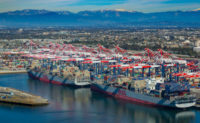City Scoop: Honolulu
Hawaii Faces Challenging Future as Upswing Ebbs

Nordic is repurposing the King Kalakaua Plaza in Waikiki into a multiuse Marriott timeshare. The firm also performed concrete work during the building’s construction in 1996.
Photo courtesy Nordic PCL

Glen Kaneshige
President
Nordic PCL
The huge wave Hawaii’s AEC sector has ridden since the pandemic may have reached its peak, but the swell continues to hold steady. Total construction starts for Honolulu, according to Dodge Data and Analytics, peaked at $6.9 billion last year, up almost 90% from 2021.
“The construction market in the Honolulu area has been very robust since the pandemic,” explains Kaneshige. “We expect the market strength to continue with the demand to build multistory, high-rise affordable residential developments to provide housing in a market that has a shortage of inventory by over 30,000 units.”
The problem facing the industry is that the post-pandemic surge was fueled primarily by the non-building sector. While residential building has risen steadily and is expected to top $1.2 billion this year, the sector still lags behind the region’s pressing need for more housing.
On the upside, the housing crunch has led to a boom in the repurposing and adaptive reuse of office towers into residential units in downtown Honolulu, Kaneshige says.
“As more people opt to live close to where they work, the business district and Chinatown areas of Honolulu could experience a revitalization as more businesses, such as restaurants, choose to open where there is an increasing residential population.”
An excellent example is Nordic’s repurposing of a defunct retail plaza in Waikiki, the King Kalakaua Plaza. Built in 1996, the four-story structure has been vacant since 2009. The rebuild will add an additional three stories and will feature two floors of retail, 110 studio and one-bedroom units, a rooftop pool, a fitness center, a bar and a 10,000-sq-ft sales gallery.
Additionally, there will be two levels of parking below the building. During construction, the basement had to be flooded to offset the buoyancy when the dead loads of the structure were reduced during demolition.
On the downside, the lack of housing has added to the already dire shortage of skilled workers for the sector to meet the current backlog and future pipeline of work—the No. 1 concern in the region’s AEC community.
Blue-and white-collar labor pools of the AEC community are shallow and static since nonresidents can’t just drive to the islands for employment opportunities, Kaneshige explains.
“The lack of affordable housing and the high cost of living make it unattractive for the nonresident workforce to relocate,” he says. “As a result, the local AEC community struggles to accommodate an expansion of the workload with a restriction in workforce capacity.”
One effort that may feel the impact of the shortage is the rebuilding of Lahaina community on Maui, which was devastated by fire last fall. Approximately 2,000 structures over an area of 2,000 acres were razed by the blaze, which killed more than 100 people while displacing more than 13,000 residents. The rebuilding effort is expected to take decades.
“Depending on the velocity of the rebuilding effort, the local labor pool on Maui will most likely be inadequate to support the amount of work, and nonresident workers willing to relocate will have difficulty finding housing,” he says.
“The local AEC community struggles to accommodate an expansion of the workload with a restriction in workforce capacity.”
—Glen Kaneshige, President, Nordic PCL
Still, several big ticket projects continue to move forward. Military construction, primarily on the island of Oahu, is very strong as the Dept. of Defense continues to bolster its facilities in the Pacific region. Meanwhile, the construction of the light rail system on Oahu continues toward downtown Honolulu.
“We eventually expect to see residential and commercial developments taking a foothold in the half-mile radius from each station zoned for high-density transit oriented development [TOD],” he notes.
One roadblock to development has been red tape. Since the pandemic, securing building permits in a timely manner from the Dept. of Planning and Permitting for the City and County of Honolulu has been a challenge.
“Delays in securing building permits after a protracted review period has frustrated developers and local residents who cannot proceed with their projects,” Kaneshige says. “Besides causing a major inconvenience to the permit applicant, the delays in the building permitting process have driven up the cost of development in a location where affordability is nearly unachievable.”




